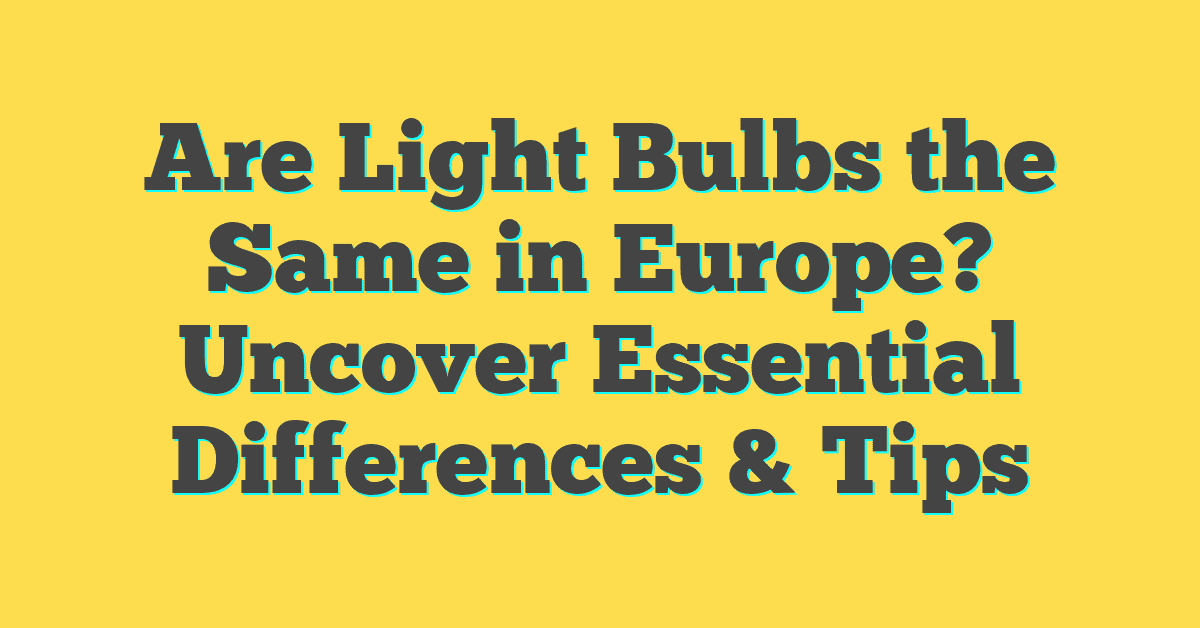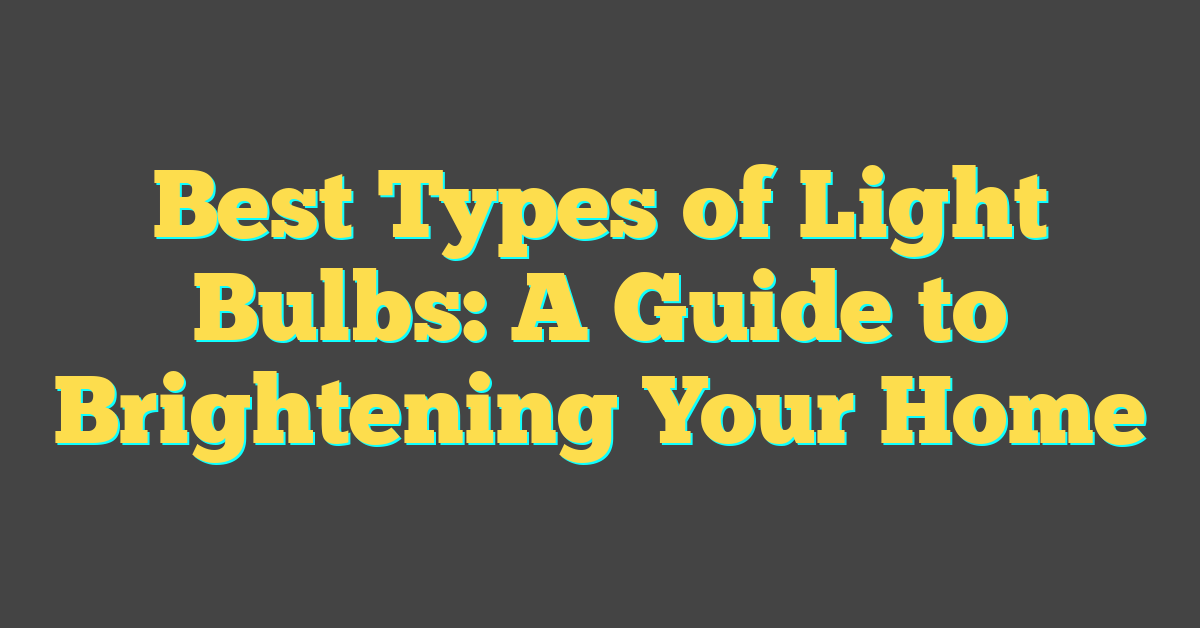Ever wondered what’s the featherweight champion in the world of light bulbs? You’re not alone. The quest for the lightest light bulb isn’t just a trivial pursuit—it’s a peek into the future of lighting technology.

Imagine swapping out your clunky old bulbs for something so light, you’d hardly know it’s there. That’s where the industry is headed, and you’re about to get the lowdown on this illuminating topic.
The Importance of Light Bulb Weight
When you’re immersed in your latest home DIY project, the weight of your lighting choices might not be the first thing on your mind. Still, the weight of a light bulb plays a crucial role in both design and function. Lighter bulbs bring forth a range of benefits that can significantly enhance your living space.
Easy Installation and Replacement
Light bulbs that are lightweight are, quite simply, a breeze to handle. You’ve been there—a precarious balance on a ladder with a light bulb in one hand and a screwdriver in the other. Lighter bulbs reduce the hassle and risk during installation or replacement.
- Less risk of dropping and breaking
- Easier to maneuver in tight spaces
- No need for heavy-duty fixtures
Better Compatibility With Modern Fixtures
Contemporary light fixtures often sport delicate designs and thin materials. A light bulb that’s light as a feather is perfectly suited for these modern aesthetics. You won’t have to worry about the strain on your elegant, minimalist chandelier or stylish pendant lamp.
- Ideal for delicate fittings that can’t support heavier bulbs
- Preserves the integrity of modern designs
Advancements in Technology
Heavier traditional incandescent bulbs are becoming relics of the past. Now, lighting technology strives to combine efficiency with convenience, resulting in bulbs that are as easy on your fixtures as they are on your electric bill. LED technology, in particular, has led the charge in producing high-quality light with minimalist design.
- Technology like LEDs require less material
- Reduced weight contributes to lower shipping and packaging costs
Remember, the lighter the bulb, the less it’ll pull on wires and sockets, extending the lifespan of your lighting fixtures. And with the advancements in LED technology, the lightest light bulb doesn’t just weigh less physically—it also carries less environmental weight, making it a clear choice for eco-conscious DIY enthusiasts.
Understanding Light Bulb Weight Measurements

When tackling a lighting project, you’ll inevitably need to consider the weight of different light bulbs. Just like you wouldn’t overlook the color temperature or wattage, the weight plays a crucial part in your selection process. So let’s dive into how light bulb weight is measured and why it matters to you, particularly as a DIY enthusiast.
Manufacturers measure light bulb weight in grams (g) or ounces (oz), providing a clear indication of how hefty a bulb will be. To give you an idea of what to expect, standard incandescent bulbs usually weigh around 20 to 40 grams, while their LED counterparts often clock in much lighter, sometimes half the weight or even less.
Why should you care about those gram figures? Simply put, lighter bulbs are easier to work with. You’ve likely been there—on the ladder, stretching to reach a fixture, and a lighter bulb just makes everything less of a balancing act. Plus, when you’re sprucing up your living space with delicate or sleek fixtures, you need to know they won’t be burdened by heavy bulbs.
Here’s what you need to keep in mind:
- LEDs are the front-runners: They top the list for being the lightest bulbs available, thanks to their compact electronics and lack of heavy components like the filaments found in incandescent bulbs.
- Lumens over grams: As you compare bulb weights, remember that brightness is measured in lumens, not weight. A lighter bulb doesn’t mean a dimmer one.
- Safety and endurance: Lighter bulbs are safer for overhead installations and can extend the life of your fixtures by reducing the physical stress on mounts and wiring.
So whether you’re piecing together the perfect ambiance for your living room or installing a new pendant light in the foyer, keep those weight measurements in mind. Your choice affects not just the ease of installation but also the longevity and safety of your lighting solutions.
What Are the Lightest Light Bulbs on the Market?

As a DIY enthusiast and lighting aficionado, you’re probably eager to identify the featherweights in the world of light bulbs. Gladly, LED bulbs stand out as the unanimous lightweights champion. These bulbs have taken the market by storm, not just for their energy efficiency but also for their minimal heft.
« How to Check If a Light Bulb Is Good: Foolproof Testing Tips
What Size Light Bulbs Go in Refrigerators? Unlock Brightness Secrets »
LEDs owe their svelte figure to their innovative design. They use tiny, solid-state semiconductors rather than the bulky glass and metal filaments found in traditional incandescent bulbs. This makes LEDs incredibly light and durable. What’s more, their weight is so negligible they can be used in a wide array of fixtures that might otherwise be overwhelmed by heavier bulbs.
Among LED bulbs, some brands have pushed the envelope to craft even lighter bulbs. Here’s a quick rundown of some of the front-runners:
- Philips Hue Bulbs: While offering smart lighting capabilities, these LEDs maintain a remarkably light profile.
- GE Lighting LED: These bulbs are touted for their lightweight design and are favored in both residential and commercial settings.
- Cree LED Bulbs: Known for their longevity, Cree’s bulbs are also among the lightest LEDs available.
Don’t forget that when you’re searching for the lightest bulbs, details matter. The weight can vary based on the bulb’s shape, size, and additional features like Wi-Fi connectivity or built-in dimming capabilities. When comparing options, it’s typically the bare-bones, no-frills LEDs that weigh the least.
Addressing practical concerns, light bulbs like these are a dream to handle. You won’t need to worry about heavy bulbs straining your hands during a day filled with installations. Plus, should an accident occur and a bulb fall, there’s minimal risk of damage due to the light impact.
Remember, a light bulb’s weight does have a tangible impact on your daily lighting experience. From easing the installation process to elongating the life of your chic fixtures, it’s an often-overlooked aspect that you, as a savvy DIYer, can’t afford to ignore. Now with the knowledge of the lightest light bulbs, you’re well-equipped to make the smart choice for your next project.
Pros and Cons of Light Bulbs with Lesser Weight

Advantages
When you choose lightweight bulbs, you’re opting for ease and versatility. Installation becomes a breeze, especially when dealing with high or hard-to-reach fixtures. There’s no need for heavy-duty support systems, and you eliminate the worry of a bulb yanking down a fixture or sagging an elegant pendant light with its weight.
Consider the following advantages:
- Reduced Shipping Costs: Lighter bulbs are cheaper to ship. This saves manufacturers and, ultimately, you, on delivery fees.
- Safety: If they do take a tumble, they’re less likely to cause injury or severe damage.
- Energy Efficiency: LEDs are not just physically lighter but also light on your energy bill, as they consume less power.
Disadvantages
However, light bulbs, like any product, have their downsides. The same features that make a bulb lightweight may also contribute to its fragility. Thin materials are more susceptible to damage from external forces.
Below are a few disadvantages:
- Material Durability: Lightweight often means thinner materials, which can be less robust.
- Heat Dissipation: Slimmer designs could potentially compromise heat management, affecting longevity.
- Compatibility: Changing to a different kind or shape of bulb may require adjustments in your lighting fixtures.
In exploring the lightest bulbs, you may also uncover that the variety in designs is somewhat limited. The drive for minimal weight sometimes comes at the expense of diverse styling options.
Remember, the lighter design is not only about the ease of installation and handling. It’s also about forward-thinking in lighting technology. LEDs are a prime example of how prioritizing weight can spur innovations that ripple through the entire lighting industry, influencing everything from the way we construct fixtures to the expansive potential of smart home technology.
The Future of Lightweight Light Bulbs

When you’re knee-deep in a home DIY project, the last thing you want is to grapple with bulky hardware. Lightweight light bulbs are a blessing, simplifying installation so you can move from task to task with ease. But beyond just a quick fix for your current project, these airy illuminators are pointing towards a bright future.
Expect leaps in material science to play a pivotal role. Innovative substances like graphene are on the horizon, offering strength without the heft. With the ongoing evolution of these materials, manufacturers could soon provide bulbs that are not just lighter but also unprecedentedly durable.
Smart home integration is another area where lightweight bulbs shine. As you integrate more automated features into your home, streamlined devices are essential. Bulbs that weigh less put less strain on moving parts, like adjustable fixtures, and can communicate with other smart devices without the need for bulky wiring or power sources. They’re the perfect companions for tech-savvy homes where convenience and functionality are key.
Let’s not overlook sustainability. Heavier bulbs require more resources not just to make, but to ship. A shift towards lightweight alternatives can significantly reduce carbon footprints, supporting a more eco-friendly lifestyle that you can be proud of.
In the industry, the push for reduced weight is influencing packaging designs as well. Slimmer, lighter packaging results in more bulbs per shipment and lower transportation costs—a win for businesses and consumers alike.
While contemplating the future of lightweight light bulbs, remember that with each gram saved, there’s potential for enhanced performance and efficiency. Whether it’s through material advances, smart home compatibility, or eco-conscious choices, you’re part of a movement that’s not just brightening homes but also paving the way for an innovative, more sustainable world.
Conclusion
You’ve seen how the world of lighting is getting a serious upgrade with the advent of lighter bulbs. They’re not just a boon for your wallet but also for the planet. Embracing these innovative designs means you’re at the forefront of a sustainable and technologically savvy home. Remember, every small change contributes to a larger impact, and by opting for these feather-light illuminators, you’re lighting the way to a brighter, more eco-friendly future. Keep an eye out for these advancements; they’re sure to shine a whole new light on your space.
Frequently Asked Questions
What are the main benefits of lightweight light bulbs?
Lightweight light bulbs offer several benefits including easier installation, reduced shipping costs, increased safety, enhanced energy efficiency, and better integration with smart home systems. They also exert less strain on moving parts in fixtures.
How do lightweight bulbs contribute to environmental sustainability?
Lightweight bulbs are more environmentally friendly due to their lower resource requirements for production and transportation. This results in a reduced carbon footprint and less waste, making them a more sustainable option.
What new materials are being used to create lighter light bulbs?
Innovative materials like graphene are being utilized to make light bulbs lighter and more durable. Graphene allows for a significant reduction in weight while maintaining strength and longevity.
Can lightweight bulbs improve smart home integration?
Yes, lightweight bulbs can improve smart home integration. Since they are lighter, they put less stress on mechanical parts and enable seamless communication with other devices, often without the need for bulky wiring.
Does the design of lightweight bulbs affect their packaging?
The push for lighter weight bulbs has also influenced packaging design. This move towards minimalistic packaging allows for lower transportation costs and further contributes to their overall sustainability.




